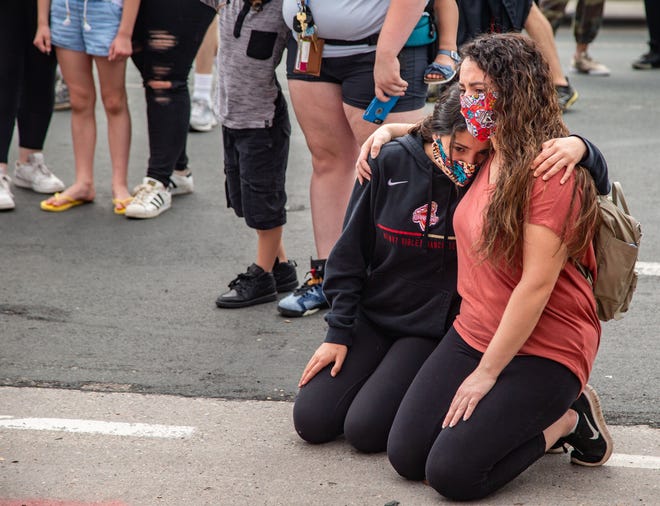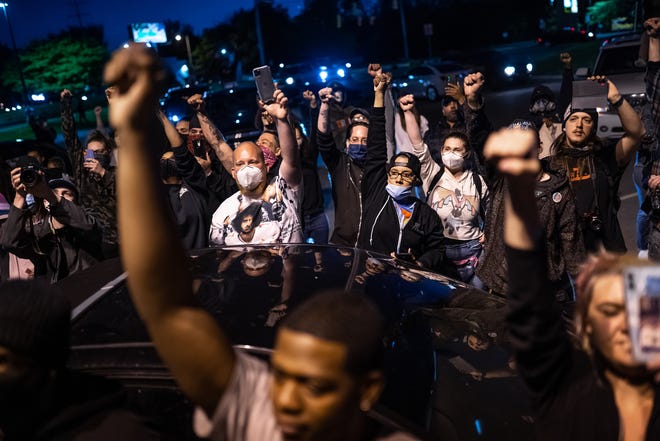
Jason Lukehart spent most of last weekend glued to scenes of protests from around the country following the death of George Floyd at the hands of Minneapolis police.
Sunday night, Lukehart, a fourth-grade teacher in Oak Park, Illinois, tapped out a message to his students’ parents: He would be holding a special Zoom session first thing Monday to talk about the unrest. He didn’t want to supersede any conversations parents were having with their own children; the additional Zoom session was optional.
The majority of his young students logged on early at 9 a.m. Lukehart, who is white, said he didn’t want to preach. He wanted students to know they could share what was on their minds.
“We’ve talked about the concept of white privilege and I was able to go back to some of those discussions,” Lukehart said. “I want my white students to have the right perspective on this stuff in an age-appropriate way. For my black students, I hope they feel like I care about them.”

In times of great political and social upheaval, schools often serve as a protected space outside the home for students to wrestle with difficult concepts, guided by an educated professional. But those conversations are hard to have right now. To start, there’s a pandemic, and school buildings are closed. It’s also the end of the academic term. Not to mention the ongoing hurdle: Many teachers are uncomfortable talking about race and racism, especially racism against black Americans.
More teachers and parents can and should talk with children about racial injustice in America, experts say. That includes conversations about police and community relations, and about the long history of white people marginalizing people of color in this country, which planted the roots of economic and racial segregation.
“Teachers can be incredibly powerful in teaching young people to engage in these conversations rather than avoid them,” said Howard Stevenson, a clinical psychologist at the University of Pennsylvania’s Graduate School of Education.
One major obstacle: 80% of the public-school teachers who would lead those discussions are white, and white people are less likely to habitually talk about race than people of color, studies show. Black teachers, who are more likely to discuss race, make up only about 7% of America’s teachers.
“White people are less exposed to what to do around race and more likely to be socialized to avoid racial matters and see them as dangerous,” Stevenson said.
The good news for breaking that cycle: Kids who grow up having more conversations about race with their parents and families are better at navigating situations around race, including speaking up for themselves, studies show. Compared with children who don’t ever talk about race, they also tend to perform better on tests of conflict resolution and anger management, Stevenson added.
“Racial socialization and literacy is more important than your own racial background,” Stevenson said.
Naming or sidestepping racism
On Memorial Day, George Floyd, a black man, stopped breathing after now-fired Minneapolis police officer Derek Chauvin knelt on his neck for more than eight minutes. Since then, major protests over racial injustice and the plight of black and brown communities have sprung up in cities across the U.S. and the world.
Tens of thousands of people have taken part in largely peaceful demonstrations, but some gatherings have been punctuated by violent encounters between police and protesters and late-night looting and vandalism.
Many superintendents and educational organizations were quick to denounce the racism that underscored Floyd’s death as well as other recent incidents where black people died at the hands of white citizens or police officers, including Ahmaud Arbery in Georgia and Breonna Taylor in Kentucky.
“The nation’s urban public schools offer our full-throated condemnation of this killing and the racism behind it,” Michael Casserly, head of the Council of the Great City Schools, said in a statement. “We vow to redouble our efforts to ensure racial justice is at the center of everything we do.”

Schools must be part of the solution because education is key to a path out of poverty, said Austin Beutner, the superintendent of Los Angeles schools — the second largest district in the country with more than 600,000 students, about 9% of whom are black.
“This tragedy must be more than a topic of conversation at every dinner table, in every board room and government hearing,” he said in a statement. “It must serve as a wake-up call to unapologetically and with conviction address the systemic bias and institutional racism which exists in many parts of society.”
Other district leaders avoided mentioning racism directly in email communications with parents. In Bernards Township School District, a wealthy New Jersey district where just 2% of the district’s 5,450 students are black, district officials initially pointed parents toward resources for addressing “frightening news” with their children.
After the message raised eyebrows among some parents, a late-night follow-up email Wednesday from the superintendent said the district would examine whether it was doing enough to educate students about racism and social justice.
Black educators share important perspectives
Outside of Flint, Michigan, Jessyca Mathews teaches English at Carman-Ainsworth High School, with an emphasis on activism and inquiry, plus a unit on protests.
Classes finished about two weeks ago, but many of Mathews’ former and current students have contacted her independently to discuss what they’re feeling.
Even if classes were in session, Mathews said, having conversations via videoconference from students’ homes would not be ideal. Many parents may not agree with the points of view students want to share, she said.
“Over Zoom, it’s like a meeting,” Mathews said. “They don’t need a meeting right now. They need a comfortable place to process what’s going on, and to think about what actions they can take.”

In normal times, Mathews’ classroom is a safe space to have those discussions. She’s black and can relate to the lived experience many of her black students are feeling.
“I’m fortunate to be able to talk about different things that white educators can’t,” she said. “I also get pushback. It’s not easy. You’ll have parents come at you, they’ll say: ‘That’s not to be discussed in the classroom.’ Or they’ll say: ‘That’s a political issue.’ “
It’s not, she said.
“Me living as a black person is not a political issue,” she said. “I respect those white educators who have taken a step to say, ‘Before I do anything, I need to listen.’ Do your research. Listen to perspectives. You’re going to hear harsh truths that you may not want to embrace.”
School leaders can encourage discussions about racial injustice by creating a place for black students to share with each other first, and then a space for the larger school community to discuss the issues, said Shaun Harper, a professor and executive director of the Race and Equity Center at the University of Southern California.
“If educators are going to engage each other and students and families around this topic, they must be willing to use words like ‘racism,’ ‘white supremacy’ and ‘anti-blackness’ in those conversations, referring to it as injustice against black people and black communities,” Harper said.
Minneapolis teachers try to connect with students
In Minneapolis, the epicenter of the protests, Southwest High School history teacher Robert Kohnert wrote a message to his 10th graders after the first explosive night.
Whatever was happening in their worlds, he said, he was there to support them. And despite any tense moments he may have had with them during the year, he said, he cared about all of them.
About 60% of the students who attend Southwest High School are white, and about 40% are students of color. Overall, Minneapolis Public Schools’ district enrollment is about 66% students of color. Yet most teachers, about 84%, are white.

Adding to the layers of inequity: Many of the most vulnerable students Kohnert and his colleagues work with are black children from disadvantaged households. Some didn’t get technology right away to do online classes. For some, food or housing is a concern. Kohnert doesn’t even know where all his students have gone.
And those students are most likely to experience the protests in profound and personal ways.
During the year, Kohnert works hard to make sure students can access versions of history from the viewpoints of non-white authors and historians. Students can choose from textbooks written by indigenous people, by Latinos or by black authors, he said. Then they all can discuss the differences.
“I tell them at the beginning that I’m a white male who is going to walk you through U.S. history, but that I’m going to do it in a flawed way,” he said. “I don’t know what it’s like to be a black person, or a woman. The recognition of that sets a certain tone for the dialogue I want them to have.”
Black youth share their thoughts
Whether adults facilitate it or not, young people are talking about race and class issues.
In Milwaukee — a city five hours south of Minneapolis but similar in its stark racial segregation — daily and nightly protests have brought hundreds of youth and adults into the streets.
“Police are supposed to protect us, but police have gained a reputation for being feared by a majority of people, especially in the black community,” said Emmanuel Komba, a 16-year-old black student at Rufus King International High School in Milwaukee.
Komba said his parents wouldn’t let him attend the protests because they didn’t want him getting hurt. But he said if school was still in session, he would have been talking about it there with students and teachers. Rufus King is an urban school with a diverse population, and issues related to racism are talked about frequently, he said.
With schools out, Komba talked with other Milwaukee teens about the protests this week during a videoconference with Urban Underground, a youth empowerment organization that helps young people engage in projects that improve the community.
Executive Director Sharlen Moore invited each of the teens to share their thoughts while on the call.
“Right now, they’re being bombarded with so many different types of messages,” Moore said. “We want to get a sense of where they are mentally and emotionally. We want to help them process their thoughts and feelings.”
For many in Milwaukee, the George Floyd protests bring back memories of Dontre Hamilton, a black man killed by an on-duty white Milwaukee police officer in 2014. Hamilton, who was mentally ill, had been sleeping on a park bench by a popular Starbucks in the middle of downtown. Protests followed his death. The city awarded Hamilton’s child a $2.3 million settlement in 2017.
Moore said many of the black teens she works with know what it feels like to not be considered a priority.
“That sort of rage has been what we’re seeing across the country,” she said. “How long are we going to continue to just be left behind as not thought of as human?”

You can check out the latest casting calls and Entertainment News by clicking: Click Here
Click the logo below to go to the Home Page of the Website
Click the logo below to follow ETInside on Twitter
Click the logo below to follow ETInside on Facebook
Click the logo below to follow ETInside on Instagram
Click the logo below to follow ETInside on Pinterest
Click the logo below to follow ETInside on Medium

















